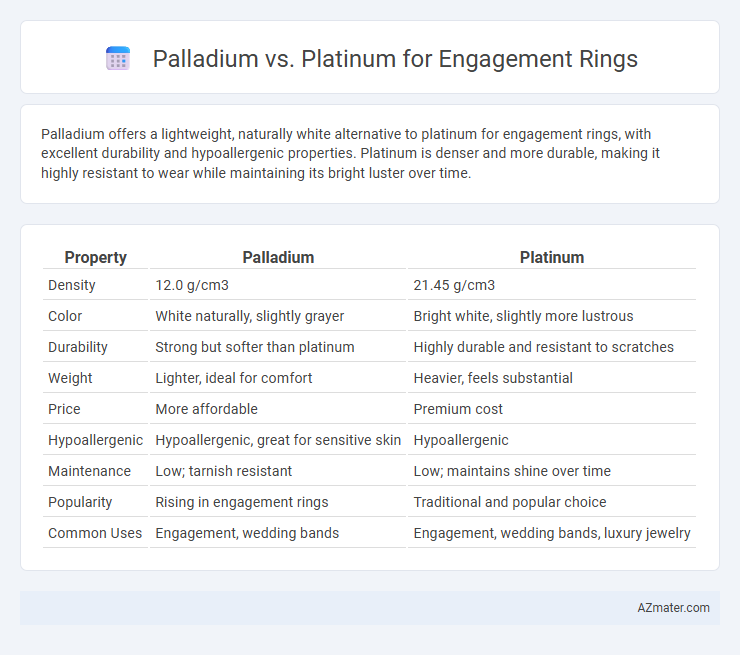Palladium offers a lightweight, naturally white alternative to platinum for engagement rings, with excellent durability and hypoallergenic properties. Platinum is denser and more durable, making it highly resistant to wear while maintaining its bright luster over time.
Table of Comparison
| Property | Palladium | Platinum |
|---|---|---|
| Density | 12.0 g/cm3 | 21.45 g/cm3 |
| Color | White naturally, slightly grayer | Bright white, slightly more lustrous |
| Durability | Strong but softer than platinum | Highly durable and resistant to scratches |
| Weight | Lighter, ideal for comfort | Heavier, feels substantial |
| Price | More affordable | Premium cost |
| Hypoallergenic | Hypoallergenic, great for sensitive skin | Hypoallergenic |
| Maintenance | Low; tarnish resistant | Low; maintains shine over time |
| Popularity | Rising in engagement rings | Traditional and popular choice |
| Common Uses | Engagement, wedding bands | Engagement, wedding bands, luxury jewelry |
Introduction to Palladium and Platinum Engagement Rings
Palladium and platinum are both part of the platinum group metals, prized for their durability and naturally white luster in engagement rings. Palladium, lighter and more affordable than platinum, offers a hypoallergenic option with a similar appearance that resists tarnishing and scratches. Platinum, known for its density and strength, provides a luxurious, long-lasting foundation for precious stones, maintaining its brilliance over time with minimal wear.
Metal Properties: Palladium vs Platinum
Palladium and platinum are both durable metals ideal for engagement rings, with platinum being denser and heavier, offering superior strength and resilience against wear. Palladium is lighter and more affordable, featuring natural white tones that resist tarnish without needing rhodium plating, unlike platinum, which usually requires periodic plating to maintain its shine. Both metals exhibit excellent hypoallergenic properties, but platinum's high density provides better protection for precious gemstones, making it a preferred choice for long-term, heirloom-quality jewelry.
Appearance and Color Differences
Palladium engagement rings exhibit a naturally white, slightly grayer hue with a matte finish, contrasting with platinum's brighter, more reflective silvery-white appearance that tends to develop a patina over time. Palladium maintains its color without requiring rhodium plating, while platinum's dense metal may show minute scratches that soften its gleam, enhancing its vintage charm. The subtle color variation between palladium and platinum influences the overall aesthetic, with palladium offering a contemporary, muted tone and platinum providing a classic, luminous brilliance.
Durability and Hardness Comparison
Palladium and platinum both offer excellent durability for engagement rings, with palladium being slightly lighter but still highly resistant to scratching and tarnishing. Platinum typically ranks higher on the Mohs hardness scale, usually around 4-4.5, compared to palladium's 4, making platinum marginally more resistant to surface wear. The choice between palladium and platinum depends on desired hardness and maintenance, as platinum develops a patina over time while palladium retains its white sheen longer.
Weight and Comfort on the Finger
Palladium engagement rings are lighter than platinum, typically weighing 30% less, which enhances comfort for daily wear. The lower density of palladium makes it ideal for those seeking a durable yet lightweight metal that won't feel heavy or bulky on the finger. Platinum rings, while heavier, offer exceptional durability and a luxurious, substantial feel that some wearers prefer despite the increased weight.
Price and Affordability
Palladium offers a more affordable alternative to platinum for engagement rings, typically costing about 30-50% less per gram while maintaining durability and a similar silvery-white appearance. Platinum's higher price is attributed to its greater density and rarity, often making it a premium choice for those seeking long-lasting luxury. Couples seeking budget-friendly options without compromising quality often prefer palladium for its cost-effectiveness and hypoallergenic properties.
Hypoallergenic Qualities and Skin Sensitivity
Palladium is highly hypoallergenic, making it an excellent choice for engagement rings worn by individuals with sensitive skin or metal allergies, as it rarely causes irritation or allergic reactions. Platinum is also hypoallergenic and often preferred for its durability and natural resistance to tarnishing, which minimizes skin discoloration and irritation over time. Both metals offer exceptional skin-friendly qualities, but palladium's lighter weight combined with its hypoallergenic properties makes it particularly suitable for sensitive skin types.
Maintenance and Care Requirements
Palladium engagement rings require minimal maintenance due to their naturally white sheen, which resists tarnishing and scratches better than platinum. Platinum rings, while highly durable and hypoallergenic, develop a patina over time that may necessitate regular polishing to maintain their shine. Both metals benefit from routine professional cleaning and inspection, but palladium's lighter weight and lower maintenance needs make it a practical choice for everyday wear.
Resale Value and Investment Potential
Palladium engagement rings typically hold strong resale value due to their rarity and growing demand in fine jewelry markets, often appreciating as platinum prices fluctuate. Platinum, renowned for its durability and density, maintains steady investment potential with high resale value, especially as global platinum reserves are limited. Both metals offer significant long-term value, but platinum's established market presence generally ensures more consistent investment returns than palladium.
Which Metal Is Right for Your Engagement Ring?
Palladium offers a lightweight, naturally white metal that resists tarnish and requires less maintenance than platinum, making it ideal for those seeking durability with minimal upkeep. Platinum boasts exceptional strength and hypoallergenic properties, providing a dense, luxurious feel that enhances the longevity of an engagement ring. Choosing between palladium and platinum depends on personal preferences for weight, price, and metal purity, with platinum typically costing more due to its higher density and rarity.

Infographic: Palladium vs Platinum for Engagement Ring
 azmater.com
azmater.com